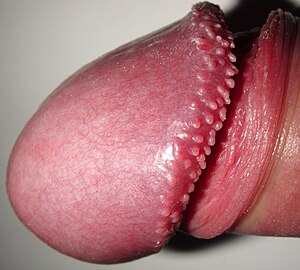Hirsuties coronae glandis
| Hirsuties coronae glandis | |
|---|---|
 |
|
| Glans penis with hirsuties papillaris glandis | |
| Classification and external resources | |
| Specialty | Dermatology |
| ICD-10 | N48.89 |
| ICD-9-CM | 607.89 |
| eMedicine | article/1058826 |
Hirsuties coronae glandis (also known as "hirsutoid papillomas" and "pearly penile papules") are small protuberances that may form on the ridge of the glans of the human penis. They are a harmless anatomical variation. Though sometimes confused with HPV infection, the papules are not a sexually transmitted infection and are not contagious.
The papules appear as one or several rows of small, pearly or flesh-colored, smooth, dome-topped bumps situated circumferentially around the corona or sulcus of the glans. They may range in size from less than 1 mm to 3 mm. As of 1999, different studies have produced estimates of incidence ranging from 8 to 48 percent of all men. Studies suggest that it occurs more often on younger men and those who have not been circumcised. One study found them in 33.3% of males who had not been circumcised and in 7.1% of circumcised males.
Hirsuties coronae glandis are sometimes described as vestigial remnants of penile spines, sensitive features found in the same location in other primates. In species which retain the full expression of penile spines, the spines contribute to sexual pleasure and quicker orgasms.
A similar expression, vestibular papillomatosis of the vulva or "hirsuties papillaris vulvae", occurs in females and similarly can be misinterpreted as an outbreak of the HPV infection. Like hirsuties papillaris genitalis, it is a normal variation on human anatomy.
While hirsuties papillaris genitalis poses no risk to a male's health, some men or their sexual partners may consider them aesthetically displeasing. There are several medical ways to remove them. Like any elective medical procedure, there is always some risk of unexpected consequences, so doctors advise against their removal unless they are causing a patient serious problems.
One of the available treatments is performed by a dermatologist, using a CO2 laser to vaporise the papules. This normally takes only a few minutes to perform. It is simple and does not normally require a hospital stay; discomfort should be minimal and the expected recovery time is one to two weeks. Another procedure involves electrosurgery performed with a hyfrecator and should take less than an hour to perform.
...
Wikipedia
